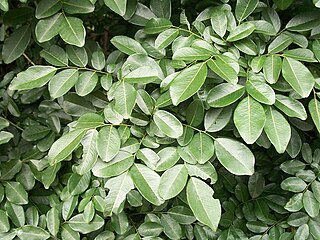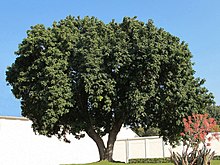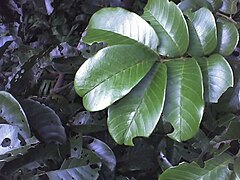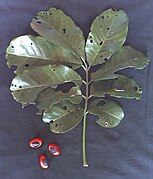
Curtisia dentata is a flowering tree from Southern Africa. It is the sole species in genus Curtisia, which was originally classed as a type of "dogwood" (Cornaceae), but is now placed in its own unique family Curtisiaceae.

Xanthocercis is a tree genus in the family Fabaceae. It includes three species native to sub-Saharan Africa.

Ilex crenata, the Japanese holly or box-leaved holly is a species of flowering plant in the family Aquifoliaceae, native to eastern China, Japan, Korea, Taiwan, and Sakhalin.

Olea capensis, the black ironwood, is an African tree species in the olive family Oleaceae. It is widespread in sub-Saharan Africa: from the east in Somalia, Ethiopia and Sudan, south to the tip of South Africa, and west to Cameroon, Sierra Leone and the islands of the Gulf of Guinea, as well as Madagascar and the Comoros. It occurs in bush, littoral scrub and evergreen forest.

Irvingia gabonensis is a species of African trees in the genus Irvingia, sometimes known by the common names wild mango, African mango, or bush mango. They bear edible mango-like fruits, and are especially valued for their fat- and protein-rich nuts.

Senecio barbertonicus, the Barberton groundsel or succulent bush senecio, is an evergreen succulent shrub of the family Asteraceae and genus Senecio, native to Southern Africa, named after one of its native localities Barberton and is now also being cultivated elsewhere for its drought resistance, clusters of sweetly scented, golden-yellow, tufted flower heads in winter and attractiveness to butterflies, the painted lady butterfly in particular.

Celtis africana, the white stinkwood, is a deciduous tree in the family Cannabaceae. Its habit ranges from a tall tree in forest to a medium-sized tree in bushveld and open country, and a shrub on rocky soil. It occurs in Yemen and over large parts of Africa south of the Sahara. It is a common tree in the south and east of southern Africa, where the odour given off by freshly-cut green timber is similar to that of Ocotea bullata or black stinkwood.

Sarcococca confusa, the sweet box, is a species of flowering plant in the family Buxaceae, probably native to western China. It is an evergreen shrub growing to 2 m (7 ft) tall by 1 m (3 ft) broad, with glossy green ovate leaves and honey-scented white flowers in winter, followed by glossy black spherical fruits, 5 mm in diameter.

Mimusops caffra is a species of tree in family Sapotaceae. This tree is found in coastal dune vegetation in Southern Africa from the Eastern Cape, through KwaZulu-Natal to southern Mozambique.

Dracaena aletriformis is commonly known as the large-leaved dragon tree. These plants are found in forest in the eastern areas of South Africa from Port Elizabeth to northern and eastern Limpopo. They are also found in Eswatini, but are most common in the coastal and dune forests of KwaZulu-Natal.

Deinbollia oblongifolia is a shrub or small tree in the family Sapindaceae. It is commonly known as the dune soap-berry and is found in coastal vegetation from the Eastern Cape of South Africa, through KwaZulu-Natal to southern Mozambique and Eswatini. It is named after Peter Vogelius Deinboll (1783–1876), a Danish botanist and plant collector.

Diospyros whyteana is a small African tree of the ebony family. Bearing dark green, strikingly glossy leaves and creamy fragrant flowers, it is increasingly cultivated in Southern African gardens as an attractive and strong ornamental tree. It can attain a height of up to 6 m.

Chionanthus foveolatus, commonly known as the pock ironwood or bastard ironwood, is a medium-sized, evergreen, Afromontane tree that is native to South Africa, Eswatini and Malawi.

Pterocelastrus tricuspidatus, commonly called candlewood, cherrywood or kershout, is a medium-sized evergreen tree, indigenous to South Africa.

Dalbergia obovata is a robust shrub or climber in the family Fabaceae, and is native to Southern Africa.

Cordyla africana is a tall, deciduous African tree with a large, spreading, much-branched crown, and a bole of some 2.2 m dbh. It is a member of the large leguminous family Fabaceae, and is known as wild mango in some areas. It is found up to 1000m elevation in large river valleys, in miombo woodland and coastal swampy evergreen forest, mostly on sandy soils, along the eastern parts of central and southern Africa. It occurs in South Africa in KwaZulu-Natal and Mpumalanga provinces, the Kruger National Park, Eswatini, Mozambique, Zimbabwe, Zambia, Malawi, Kenya and Tanzania. 'Cordyla' is from the Greek word 'kordyle', meaning a 'club' and is a reference to the club-shaped fruit and stalk.

Diospyros dichrophylla (Gand.) De Winter is a Southern African tree belonging to the ebony family of Ebenaceae and closely related to the Persimmon.

Euclea crispa, commonly known as the blue guarri, is an Afrotropical plant species of the family Ebenaceae. The hardy and evergreen plants may form a dense stand of shrubs, or grow to tree size. It is widespread and common in the interior regions of southern Africa, and occurs northward to the tropics. Though some are present near the South African south and east coasts, they generally occur at middle to high altitudes. It is readily recognizable from its much-branched structure and dull bluish foliage colour. Those bearing lanceolate leaves may however resemble the Wild olive, another common species of the interior plateaus.

Maerua cafra (DC.) Pax is a small Southern African tree belonging to Capparaceae, the caper family, occurring eastwards along the coast from Knysna, then further inland and northwards through KwaZulu-Natal and Eswatini to the Transvaal, southern Mozambique and southern Zimbabwe. The genus Maerua comprises about 60 species found in Africa and Asia.

Pterocelastrus echinatus is a small Southern African tree occurring in South Africa, Mozambique, Zimbabwe, Eswatini, and Malawi. This species is found in montane and submontane evergreen forests, forest margins, rocky hillsides, and kloofs, growing between 600 and 2400 m above sea level.
























